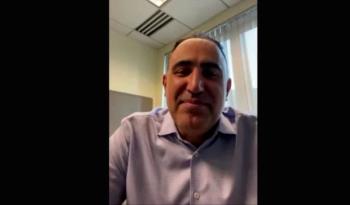
- January 2024
- Volume 30
- Issue 1
- Pages: SP36-SP37
Findings Suggest Utility of Specialized MRD Testing in Management of FLT3-ITD AML With Quizartinib
Measurement of minimal residual disease (MRD) following treatment of blood cancers is recognized as an important tool for disease management, and MRD negativity is increasingly a benchmark in clinical trials.1 However, widespread use of MRD requires tests that are sensitive enough to detect the cells in question and not so time-consuming or cumbersome that they slow decision-making.
Historically, standard MRD detection methods were inadequate for FMS-like tyrosine kinase 3- internal tandem duplication (FLT3-ITD), a common, recurrent gene mutation in acute myeloid leukemia (AML) that signals a high likelihood of relapse and poor prognosis. More recently, MRD tests specific to FLT3-ITD have been developed; for example, scientists at the Charité University of Medicine in Berlin, Germany, shared their methodology for an open-access FLT3-ITD– specific assay, getITD.2
In April 2023, investigators for the phase 3 QuANTUM First trial (NCT02668653), published results in The Lancet, which showed that adding quizartinib, a second-generation FLT3-ITD inhibitor, to chemotherapy with or without allogeneic hematopoietic stem cell transplant decreased the relative risk of death by 22.4%in adults aged 18 to 75 years who had newly diagnosed FLT3-ITD positive AML, compared with chemotherapy plus placebo.3 Then, in July 2023, FDA approved quizartinib, marketed by Daiichi Sankyo as Vanflyta, for use with chemotherapy in induction and consolidation and as a maintenance monotherapy for adult patients with FLT3-ITD positive AML when detected with an FDA-approved test.4
Additional results from QuANTUM First, published at the 65th American Society of Hematology Annual Meeting and Exposition on December 11, 2023,5 explored the relationship between complete remission (CR), overall survival (OS), and measurable MRD in these newly diagnosed patients. Investigators explained that genomic DNA from patients in the trial was isolated from bone marrow or peripheral blood following remission after 1 or 2 courses of induction therapy and at the end of consolidation, prior to transplant or the continuation of therapy. Investigators used a specially developed FLT3-ITD assay6 and noted that any mutations detected after induction were “cross-validated” against the patient samples collected at enrollment.
“Using a custom bioinformatics program, ITD mutations were identified, and variant allele frequencies (VAF) were calculated with a sensitivity of 10−5. MRD was classified as undetectable (using the 0 cutoff) or detectable above or below a 10−4 predefined cutoff (based on lower limit of quantification for the assay),” the investigators wrote.
Then, the investigators evaluated CR, composite CR (a combination of CR plus those with CR but incomplete hematological and/or platelet recovery), and the rate of patients who achieved composite CR during induction with no MRD between the treatment and placebo arms. They also looked at FLT3-ITD during induction and during consolidation between the 2 arms.
Results. There were 539 randomly assigned patients; 268 were in the quizartinib arm and 271 were in the placebo arm. Among all patients, 368 (68.3%) achieved composite CR after 1 or 2 courses of induction and 321 had MRD analysis, including 162 in the quizartinib arm and 159 in the placebo arm.
MRD was later assessed in 337 patients, including 172 in the quizartinib arm and 165 in the placebo arm, after up to 4 cycles of consolidation treatment prior to maintenance. Of these patients, 166 also received a transplant (87 in the quizartinib arm, 79 in placebo). Findings showed the following:
- The percentage of patients achieving composite CR at end of induction with FLT3-IND MRD of 10-4 was similar between the study arms (25.4% quizartinib vs 21.8% placebo; nominal P = .3430).
- However, a larger share of patients in composite CR had undetectable MRD in the quizartinib arm than in the placebo arm (12.3% vs 7.0%; nominal P = .0403).
- Evaluating patients who achieved composite CR by the end of induction, those receiving quizartinib had lower median best FLT3-ITD VAF by the end of consolidation, compared with those receiving placebo (0% vs 0.0017%; nominal P = .0006).
- Using the 0 cutoff at the end of induction, a longer OS was observed among those taking quizartinib vs those taking placebo, regardless of MRD status (HR, 0.789 in MRD negative patients; HR, 0.749 in MRD-positive patients). In MRD-positive patients, the median OS was not reached with quizartinib, compared with 35.4 months with placebo.
- In an analysis with an MRD cutoff of 10‒4, findings were similar (HR, 0.696 in MRD negative patients; HR, 0.800 in MRD-positive patients).
“These findings demonstrate the potential prognostic utility of FLT3-ITD–specific MRD measurements in the clinical management of patients with FLT3-ITD-positive AML,” investigators wrote. “Our data suggest that long-term OS benefits conferred by [quizartinib] in part derive from a deep and sustained reduction of the FLT3-ITD-positive leukemia burden.”
The authors said they will present MRD analyses regarding patients with and without transplant at a later date.
Safety Findings. A separate abstract delineated safety results by age; previously, investigators had highlighted the fact that QuANTUM-First was the first trial among patients with this common mutation in AML to include patients up to aged 75 years fit for intensive chemotherapy.7,8 Generally, data showed that rates of treatment-emergent adverse events (TEAEs) of grade 3 or higher were similar in both arms during induction and consolidation, but grade 3 or higher events were more common in the quizartinib arm during the maintenance phase.
Overall, there were 30 (11.7%) cases of “AEs associated with fatal outcome” in the quizartinib arm and 26 (9.7%) in the placebo arm. These AEs became more likely as patients’ age increased across both arms. In the quizartinib group, the rates were 8.8% among those younger than 60 years, 10.8% among those aged 60 to 64 years, and 17.4% among those 65 years or older. In the placebo group, the rates were 7.5%, 7.0%, and 16.5%, respectively. However, the data show that infections were by far the most common cause of fatal AEs, with most occurring in the induction phase; 4 drug-related fatal AEs were reported in both the treatment and placebo arms.7
Cytopenias and QT prolongation, a condition of extended intervals between the heart contracting and relaxing, were the most common AEs leading to dose modifications, and both were more common with quizartinib than with placebo, investigators found. “There was no evidence of increasing toxicity with long-term quizartinib therapy for up to 36 cycles,” they wrote, “and no new AEs were observed in patients receiving more than 12 cycles.”7
References
- Heuser M, Freeman SD, Ossenkoppele. 2021 Update on MRD in acute myeloid leukemia: a consensus document from the European LeukemiaNet MRD Working Party. Blood. 2021;138(26):2753-2767. doi:
10.1182/blood.2021013626 - Blatte TJ, Schmalbrock LK, Skambraks S, et al. getITD for FLT3-ITD-based MRD monitoring in AML. Leukemia. 2019;33(10):2535-2539. doi:10.1038/s41375-019-0483-z
- Erba HP, Montesinos P, Kim HJ, et al. Quizartinib plus chemotherapy in newly diagnosed patients with FLT3-internal-tandem-duplication-positive acute myeloid leukaemia (QuANTUM-First): a randomised, double-blind, placebo-controlled, phase 3 trial. Lancet. 2023;401(10388):1571-1583. doi:10.1016/S0140-673(23)00464-6
- FDA approves quizartinib for newly diagnosed acute myeloid leukemia. FDA. July 20, 2023. Accessed January 1, 2024. https://bit.ly/3S2CNyo
- Perl A, Erba HP, Pau M, et al. QuANTUM-First trial: FMS-like tyrosine kinase 3-internal tandem duplication (FLT3-ITD)–specific measurable residual disease (MRD) clearance assessed through induction (IND) and consolidation (CONS) is associated with improved overall survival (OS) in newly diagnosed (nd) FLT3-ITD+ AML patients (pts). Presented at: 65th American Society of Hematology Annual Meeting and Exposition, December 9-12, 2023; San Diego, CA: Abstract 832. https://ash.confex.com/ash/2023/webprogram/Paper186785.html
- Levis M, Shi W, Chang K, et al. FLT3 inhibitors added to induction therapy induce deeper remissions. Blood. 2020;135(1):75-78. doi:10.1182.blood.2019002180
- Erba HP, Dombret H, Perl A, et al. QuANTUM-First: safety by treatment phase and by age in newly diagnosed (nd) patients (pts) with FMS-like tyrosine kinase 3-internal tandem duplication (FLT3-ITD) positive acute myeloid leukemia. Presented at: 65th American Society of Hematology Annual Meeting and Exposition; December 9-12, 2023; San Diego, CA: Abstract 972. https://ash.confex.com/ash/2023/webprogram/Paper186206.html
- Erba HP. Dr Erba on the FDA approval of quizartinib plus chemotherapy in FLT3-ITD positive AML. OncLive. July 20, 2023. Accessed January 1, 2024.
https://bit.ly/3TKUiEK
Articles in this issue
over 1 year ago
Overcoming Barriers to Care Equity in Multiple Myelomaover 1 year ago
ASH 2023: Coverage in MDS, Myeloproliferative Diseaseover 1 year ago
ASH 2023: Coverage in Multiple Myelomaover 1 year ago
ASH 2023: Coverage of ALLover 1 year ago
ASH 2023: Coverage of cHLover 1 year ago
ASH 2023: Coverage of MCLover 1 year ago
ASH 2023: Coverage of CLL/SLLover 1 year ago
ASH Abstracts Showcase Effective Treatments for MM, CLL, FLNewsletter
Stay ahead of policy, cost, and value—subscribe to AJMC for expert insights at the intersection of clinical care and health economics.














































